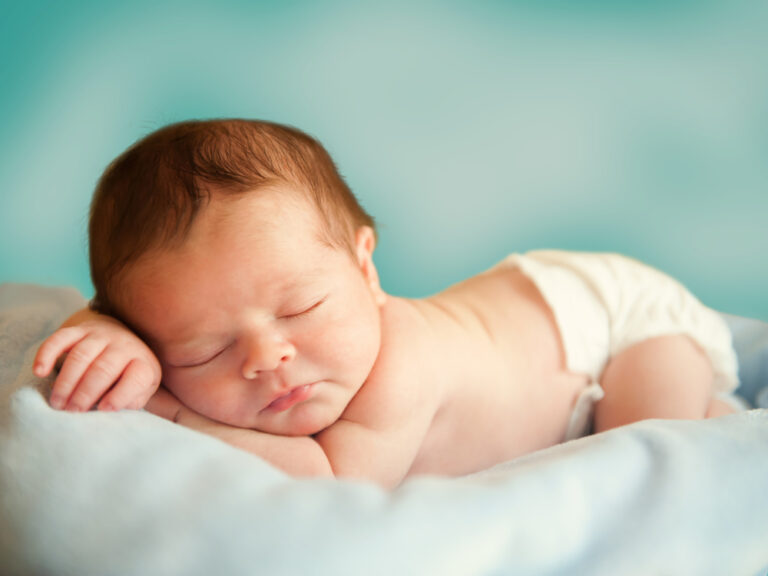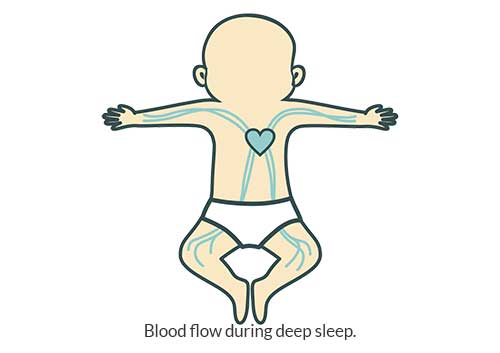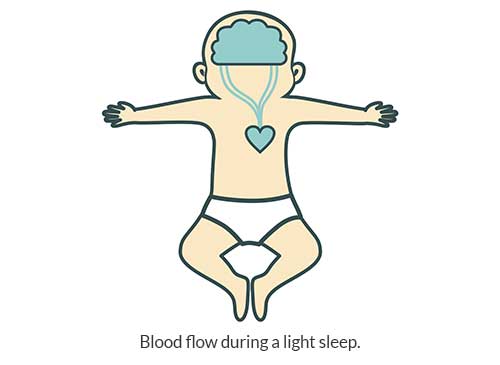We all know that newborn babies require more sleep than adults do, due to their growing and developing.
But, did you know how different a baby’s sleep pattern is to ours?
A baby is born with only 25% of its eventual brain volume, and that grows to nearly 70% of adult volume in just the first two years of life!
Brain development, as well as physical recovery and growth, occur during sleep, and so it is no wonder that newborns spend up to 18 hours a day doing it.
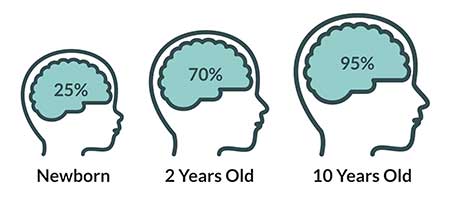
Newborn baby sleep occurs in 3-4 hour stretches interrupted mainly by feeding. Having some insight into what happens during these stretches of sleep is necessary to help you to understand your precious little one, why they wake so easily and why they appear, at times, to have a fitful sleep.
So what are the stages of sleep?
Deep sleep
Deep sleep or quiet sleep is known as Non-Rapid Eye Movement (NREM) sleep in adults. This stage of sleeping helps to restore physical energy and aid in the growth of the body. It does this by directing blood away from the brain to our muscles. The brain wave activity is very slow during our deep sleep.
As adults, we start our sleep cycle by entering directly into the deep sleep. I know it doesn’t always feel like it, but that is because this stage is broken up into three distinct phases:
The first stage lasts approximately 5 minutes and helps us prepare for sleep, but our eyes are closed. If we wake during this, it can feel like you have never been asleep.
The second stage is called true sleep, and it can last between 10 and 25 minutes.
The final stage is the actual deep sleep. This is when we have difficulty awakening from our sleep, and if we do, we feel very groggy and can feel that we have woken up on the wrong side of the bed.
Light sleep
With the deep sleep completed we then enter our light stage of sleep. Light sleep, is also known as active sleep, or Rapid Eye Movement (REM) sleep in adults. This is the dreaming stage of sleep. We call it light sleep as we are easily woken from this, but it is also known as active sleep. During this stage of sleep, the blood flow to the brain is doubled, and the brain is very active, hence all that dreaming.
Active sleep is vital for processing information that we have taken on board during the day and storing it. It is what helps us form long-term memory, and it is essential for our brain development.
The light stage becomes increasingly longer with each sleep cycle, hence why we often wake up dreaming in the morning and remember our dreams.
At the end of this stage, we have completed one sleep cycle.
Adult sleep cycles last 90-110 minutes with about 25% of our sleep spent in the light stage and consequently 75% in deep sleep.
How do babies sleep?
Newborns have an entirely different sleep pattern from adults. One complete sleep cycle is only approximately 45-60 minutes and babies enter directly into a light sleep instead of starting with the deep sleep as we adults do. Newborns (0-6 months) spend 50% of their sleep cycle in a light sleep and 50% in a deep sleep allowing more time for their brain to develop.
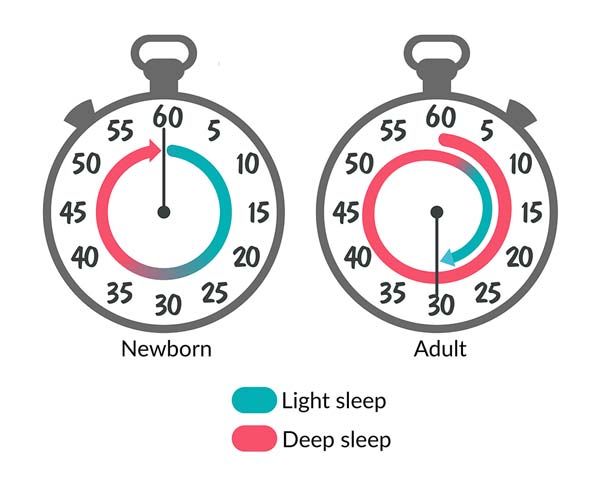
How do we know which stage of sleep our baby is in?
I’m sure you have noticed you just seem to get your little one off to sleep but then suddenly the slightest movement or noise, and they are wide awake again. That happens to them all and that is because they start with their light sleep. They stay in the light sleep with a very active brain for 20-30 minutes.
You can note changes in your baby’s movements at this stage, such as fluttering eye movements, grinning or grimacing, irregular or fast breathing and they may startle or move their limbs. Other changes happen that we cannot see, such as an increase in blood pressure and heart rate. This is allowing for greater blood flow to your baby’s brain to help build memory and thus, promote brain development.
The light stage of sleeping is in fact also a defense mechanism for young babies and an important survival technique. As they sleep lightly, they can wake if they are in danger i.e. too hot or cold, hungry, have difficulty breathing with a snuffly nose, or if something is obstructing their airway. They can cry out for help to get your attention and, therefore, protect themselves from danger.
When they enter deep sleep, there are no active eye movements. Their breathing becomes more regular, and muscle activity slows causing them to lie very still. You can lift their arm or move a hand, and it will fall back into place without them batting an eyelid. The heart rate slows down, and this stage promotes physical recovery and growth of the body.
By six months of age, their sleep pattern has changed a little. Babies now only spend 30% of the time in the light stage, and you will be glad to hear, nearly 70% is spent in deep sleep. You will notice that you too will be enjoying a few extra well-deserved hours of sleep!
Conclusion
By now you should have a better understanding of how our babies sleep and how different this is to our sleep pattern.
What differences have you noticed in your baby’s sleep? Please let the community know by leaving a comment or question below.
